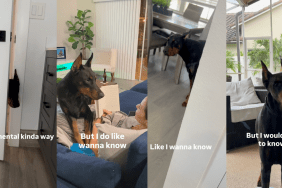Less than 24 hours after his dog was euthanized Tuesday, soap opera actor Nick Santino took his own life. The grief was too much to bear.
Santino once said of his adored Pit Bull mix, “I didn’t rescue Rocco. Rocco rescued me.” That idea is a common refrain among those who adopt shelter dogs, but for Santino, the pronouncement seems especially appropriate. Placed in an orphanage at the age of five months, Santino’s childhood proved a steady stream of unknowns and inconsistencies; he spent his years prior to age sixteen in a total of nine different foster homes.
For Santino, Rocco must’ve been a constant — perhaps the unfailing sense of family he’d never known with humans. But in 2010, management at Santino’s apartment building passed a strict anti-Pit Bull law. Already a resident, Rocco was grandfathered in, but Santino endured constant harassment from others in the building. After months of pressure, Santino made the gut-wrenching decision to put Rocco down.
I don’t have an answer as to why Santino didn’t move to another apartment —maybe he did look for alternative housing, I don’t know. I do know that finding a rental is complicated if you have animals, and a true challenge if you have a Pit Bull. One report described Santino as “down on his luck” — perhaps between that, the ongoing harassment, and horror at the idea of surrendering his dog to a shelter (if anyone gets a pass for not wanting to send a loved one back into a system with no guarantees, it’s Santino), he truly felt this was the best option.
But there’s no question the decision to euthanize Rocco ultimately cost Santino his own life. “Today I betrayed my best friend,” he said in his suicide note. “Rocco trusted me and I failed him. He didn’t deserve this.”
I wish I could’ve told Santino that I understand.
An animal shelter is one of the few environments in which caretakers routinely end the lives of those they were once tasked with saving. As a volunteer, I’ve been present for euthanasias that truly seemed to take place painlessly and quickly — and for others that were marked with seizures, struggles, and terror.
When I know it’s an animal’s time — that is, when I know his time is up — I try to make sure those last few minutes offer some joy. A final walk along his favorite route, a last session of fetch, an extended belly rub and a coveted treat. But there’s no getting around it: Eventually, I’ll be leading this animal to a room he’ll never leave. It doesn’t matter that I don’t touch the needle; the sense I’m somehow complicit in this ultimate betrayal leaves me shattered every time.
Just as with the 10,000 shelter animals who are put down each and every day, Rocco’s death was not relief for incurable suffering. Therefore, it was not a euthanasia in the true sense of the word: a “good death.” Rather, it was an act performed out of fear, a somber ramification of breed profiling gone awry.
Certainly humans did fail Rocco, but I would argue that it wasn’t Santino, the man who rescued this dog and gave him years of love and security. Instead, we all failed Rocco. As a population, we have failed to adequately disable those that abuse their animals or purposely “train” them to become vicious and distrustful. We have allowed stereotypes and fear mongering to end the lives of millions of innocent beings.
I do believe there are fates worse than death — months in some of this country’s animal shelters would qualify. (And while I know that No Kill advocates would argue,) I also believe there are fewer good homes than there are animals currently in need. We simply have too many dogs and cats. But the solution to overpopulation is not killing; it’s prevention. And the solution to fear is not breed discimination, it’s education.
Said James Steven Grant, one of Santino’s former neighbors, “Rocco was the sweetest dog in the world. Rocco wouldn’t hurt a fly.”









